The offseason is a time for teams to reflect on their prior season and address their weaknesses via the free agency and via the NFL draft. With free agency now well in the books and the draft only a day away though, the 32 NFL franchises now have one last chance to secure their weaknesses and build a team that can contend for the Super Bowl LIV title.
If we've learned thing over the last decade it's that drafting for need is never the most valuable tactic, instead, drafting the best player available is almost always the correct play. However, in rare cases, teams find themselves in the position of selecting the player who fits both categories – a player that is both the best player available and just so happens to play the team's biggest position of need. Below, we take a look at all 32 NFL teams and detail the best player for that team's specific need.
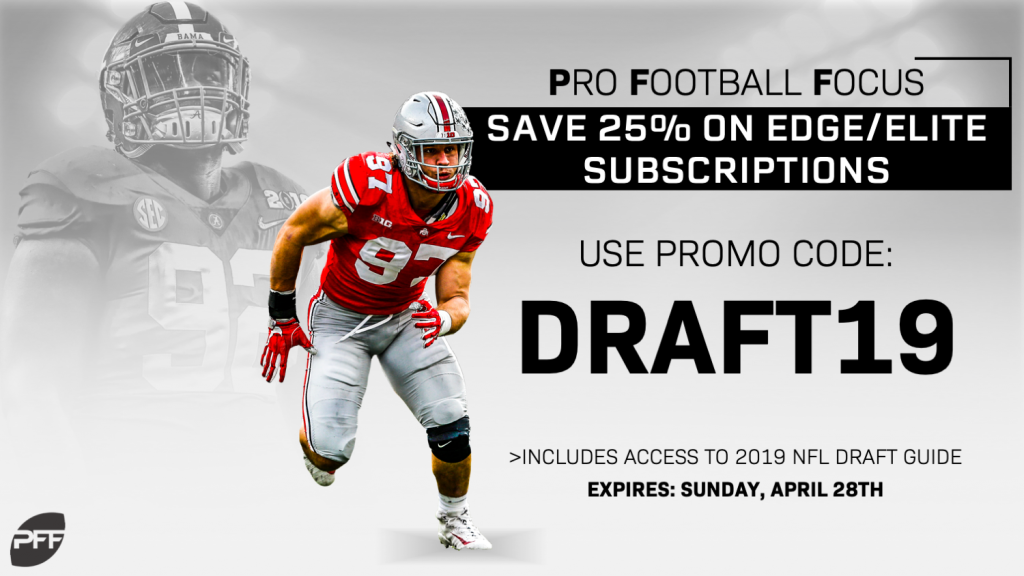
[Editor’s Note: To view more of Pro Football Focus’ advanced stats and grades for draft-eligible players, check out our 2019 NFL Draft Guide. All EDGE and ELITE subscribers already have access to the guide, and for those who don’t, you can get your copy for as low as $9.99!]
The Bills had a rough year in 2018, finishing 6-10 that also saw them finish with the lowest receiving grade in the NFL this past season, and despite their addition of John Brown and Cole Beasley in free agency, their unit of pass-catchers should still be a priority come draft time. Robert Foster exploded onto the scene for the Bills this season, finishing with a receiving grade of 73.3 while no other Buffalo player finished with a receiving grade of 65.0. It was clear during free agency that their approach was to surround second-year signal-caller Josh Allen with weapons, and that shouldn't stop with free agency.
Draft Target: Marquise Brown, WR, Oklahoma
With the ninth overall pick in the draft this year, Buffalo could have their pick of the litter in terms of receivers, or they could wait to see how things shake out and select a viable pass-catcher in the second round. A possible option on Day 2 could be Oklahoma WR Marquise Brown, who was a deep threat during his time with the Sooners. Brown racked up the sixth-most deep receiving yards with Oklahoma and hauled in five deep touchdowns in 2018. An injury and his slight stature may cause his slide into the latter stages of the draft as he checked in at the combine at just 5-foot-9, 166 pounds and is currently rehabbing from a Lisfranc injury. Regardless, with the need to give Allen more weapons, a first-round type player in Day 2 would make a lot of sense for Buffalo.
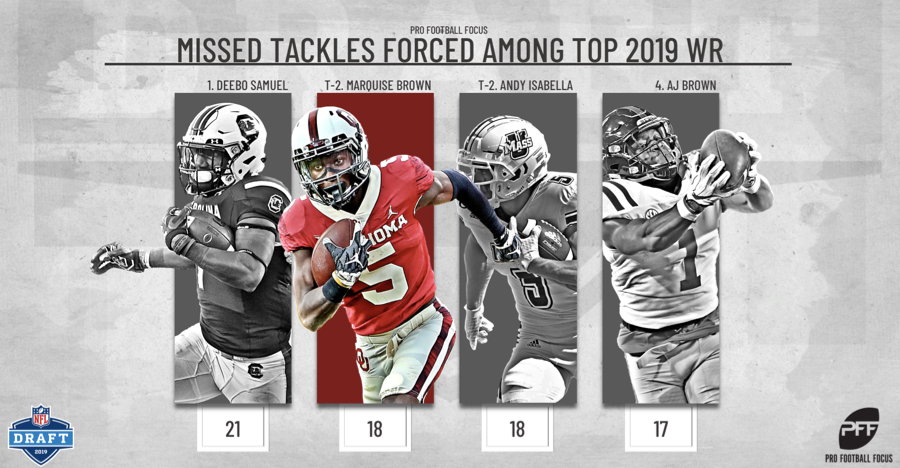
After trading away quarterback Ryan Tannehill to the Tennessee Titans and replacing him with Ryan Fitzpatrick, the quarterback position will almost certainly be high up on the team's list of priorities. However, if the Dolphins aren't sold on a signal caller at Pick 13, there are some other spots the Dolphins could look to bolster. While offensive tackle Laremy Tunsil had his best year with the Dolphins and worked his way to a career-high overall grade of 70.4, the rest of the offensive line struggled. There is now a glaring hole at right tackle thanks to the departure of Ja’Wuan James, and only one interior offensive lineman finished with an overall grade of above 60.0 last year.
Draft Target: Greg Little, T, Ole Miss
Little had a great 2018 season with Ole Miss, and his ability in pass protection could go a long way in shoring up the Dolphins' offensive line. Little finished the season with a pass-blocking grade of 87.8 — the highest pass-blocking grade of his college career — and he allowed just six sacks on 1,366 career pass-blocking snaps. Although he has proved to be a good pass blocker, the one question that NFL teams will have for Little is his run-blocking ability. In 2018, Little finished with the lowest run-blocking grade of his career with at 63.2, and if he falls on draft day because of it, he could represent a steal for the Dolphins in the second round.
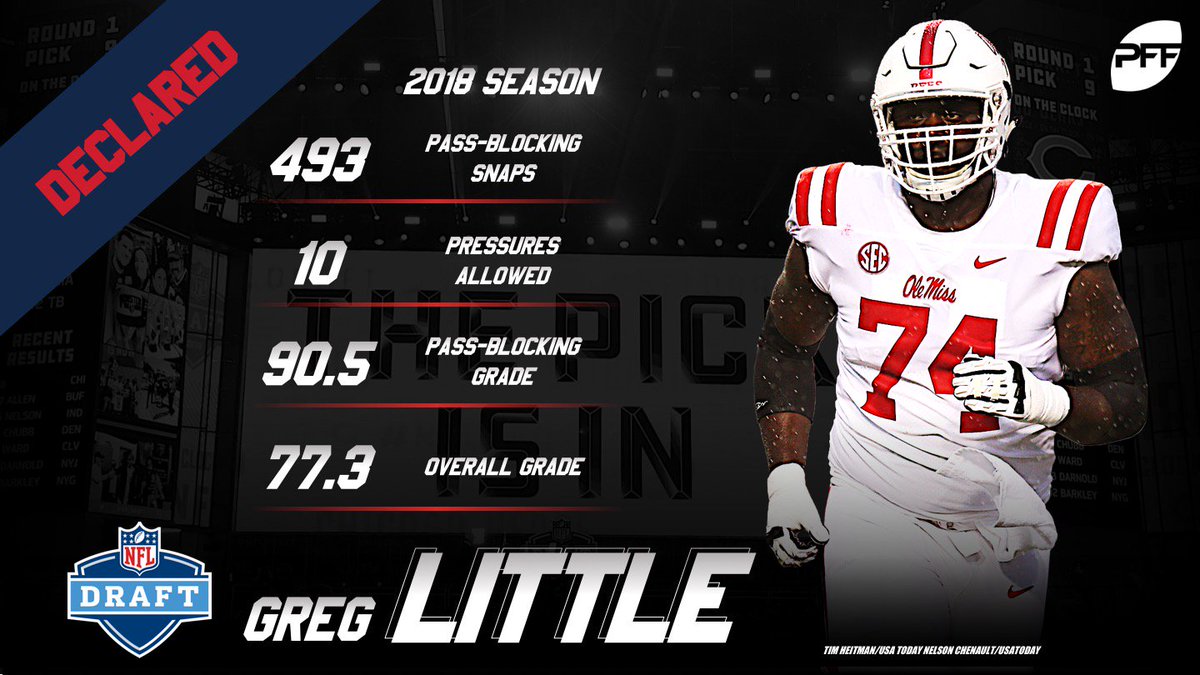

The Patriots finished the 2018 season with their third Super Bowl title in five years, and their defense was a major reason why. That being said, the team could still stand to improve their pass rush. The Patriots finished the 2018 season with the 19th-lowest pass-rushing grade, and their best performer in that department (Trey Flowers, 79.9 pass-rush grade) has since set sail for Detroit, leaving behind a huge hole at the edge position.
Draft target: Zach Allen, Edge, Boston College
Twenty-five miles away from Gillette Stadium is an edge player out of Boston College who could certainly help out the Patriots' edge-rushing problem. This past season, Allen put up the highest overall grade of his career (90.9), with a career-high run-defense grade (87.7) to boot. While he has been a consistently dominant run stopper in college, this year he really stepped up his pass-rushing game; he posted a career-high in pressures as well as a career-high in quarterback hits. Allen would likely be there at Pick 32 and the Pats could even hope he slides to the latter stages of Round 2 in a talented edge defender class.
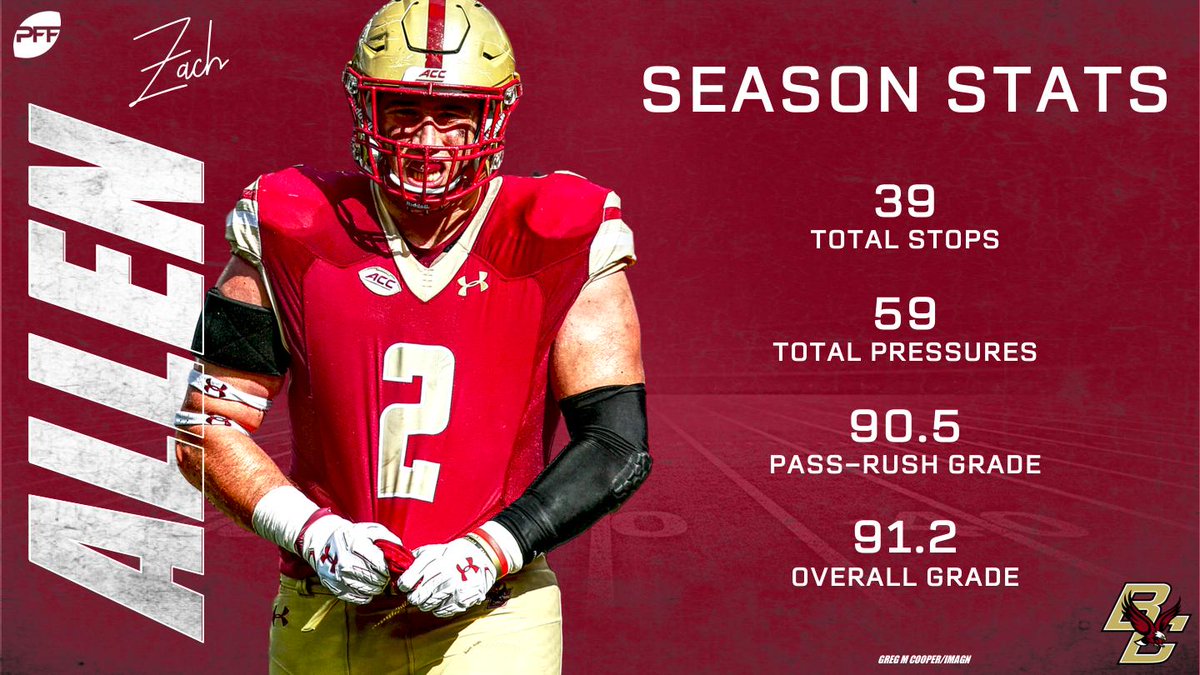

The Jets have made some headline-grabbing moves this offseason, most notably by signing former Steelers running back Le’Veon Bell, but adding Bell to this roster will do little to help the team from a rushing perspective if they don't improve upon a run-blocking performance that earned the second-worst run-blocking grade in the NFL last year. The poor offensive line play coupled with a lack of star power at the receiver position could mean that the Jets look towards the offensive side of the ball on Thursday night, but there is a need more pressing than even that, as the team's defense is (and has been for some time) lacking a productive edge defender that can consistently put the opposing quarterback under pressure. As things stand, none of the team's edge defenders managed to earn a pass-rushing grade above 62.7 last year, making the position a glaring need.
Draft target: Josh Allen, Edge, Kentucky
This past college season, Josh Allen shot up draft boards with a mightily impressive year with Kentucky, in which he had more sacks than every year before combined. Allen only had one game this entire season in which he didn't get at least three pressures, and he led the SEC with 57 total. He earned a 94.3 pass-rushing grade on the year — the best mark in the nation — and for the Jets, he will most likely be the rare combination of best player available at the biggest position of need.

With Joe Flacco now out of town, the offensive reins are firmly in the hands of second-year quarterback Lamar Jackson, and the best thing that the Ravens could do to help out their young quarterback is to give him more (and better) offensive weapons to work with. Having lost veteran receiver Michael Crabtree as well as deep-threat John Brown, there are holes at the receiver position. While young tight end Mark Andrews had a good year at tight end with an overall offensive grade of 75.7, the Ravens will have to look to add a weapon on the outside or in the slot to help open up the offense more for their young signal-caller.
Draft target: A.J Brown, WR, Ole Miss
Brown had another solid year with Ole Miss in 2018, producing a career-high in receiving yards (1307) and grading above 79.0 for the second consecutive year. Brown was the definition of a complete receiver last year: He forced 17 broken tackles, had 34 explosive plays and only dropped five passes on 90 catchable. He should be a good pick up for the Ravens who has potential to be a solid wide receiver in the NFL.
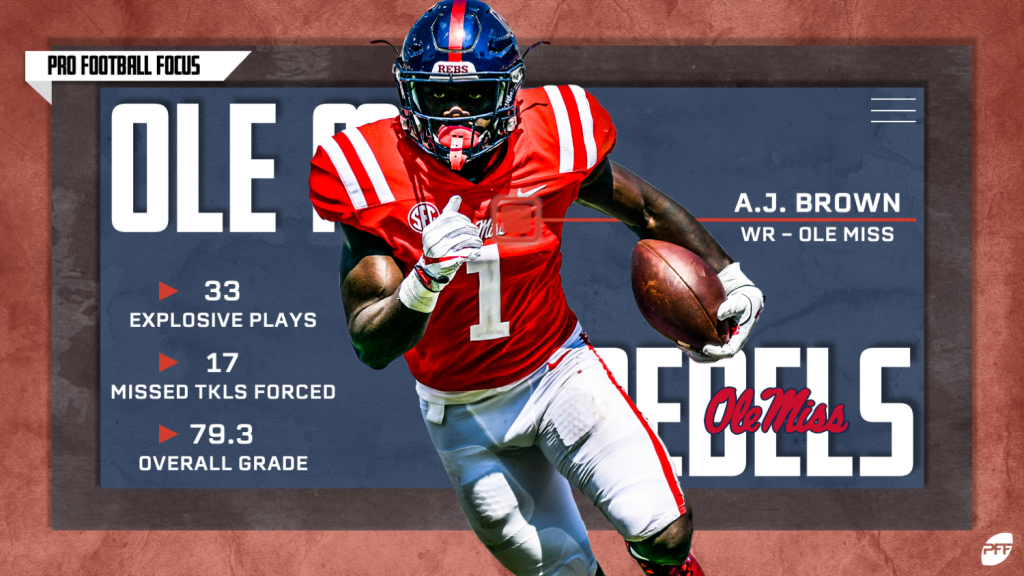
After Cordy Glenn (60.9 overall grade) and Bobby Hart (56.2) finished the 2018 season on a disappointing note, one wouldn't blame the Bengals for looking for offensive line help somewhere in the upcoming draft. There is a more pressing need on the other side of the ball, however, as the Bengals also did not have a linebacker grade above a 60.0 last year. In today's NFL, where linebackers are being asked to play coverage more than ever, the Bengals will enter the draft without a single linebacker with a 2018 coverage grade of 60.0 or higher, making the position a clear cut area of need.
Draft Target: Devin White, LB, LSU
White finished the 2018 season the highest defensive grade of his college career, which helped him secure a spot within the top 20 on the PFF Big board. White would be the perfect answer to the Bengals' coverage problem from the linebacker position, as he finished with the highest coverage grade (91.6) of any linebacker in the nation. The Bengals have the 11th pick in the draft this year, and White is still available, the card should be sprinted down to the table.

The Browns put forth the lowest tackling grade in the NFL last season, and they could benefit from taking a close look at the safeties and cornerbacks in this class. The Browns recently brought in one of the best receivers in the league in Odell Beckham Jr., but with that, they also lost safety Jabrill Peppers, and with his departure, there is now only one defensive back on the team who finished with a grade above 75.0.
Draft Target: Deionte Thompson, S, Alabama
Thompson could be a good pick up in a later round. He saw career-highs in both overall grade and coverage grade this past season, and despite late-season struggles, he'd certainly be a good pick up for the Browns should he fall to them in the draft.

While the Steelers could certainly benefit from an injection of talent to bolster the receiving corps, they also desperately need defensive reinforcement on the backend. Last season, the Steelers finished with the league's 18th-lowest coverage grade, and they did not have a single safety or cornerback finish with a coverage grade above 75.0. The Steelers don't have a star in their secondary so if one falls to them at the right place, it would be a good move for the team.
Draft target: Deandre Baker, CB, Georgia
Baker followed up a very good 2017 season with an excellent 2018 season, which he finished with an elite coverage grade of 90.0 — the second-highest coverage grade amongst corners in the SEC. This past year, he allowed all of 10 first downs all season, he allowed no touchdowns, and he allowed a passer rating of just 40.2 on throws into his coverage.
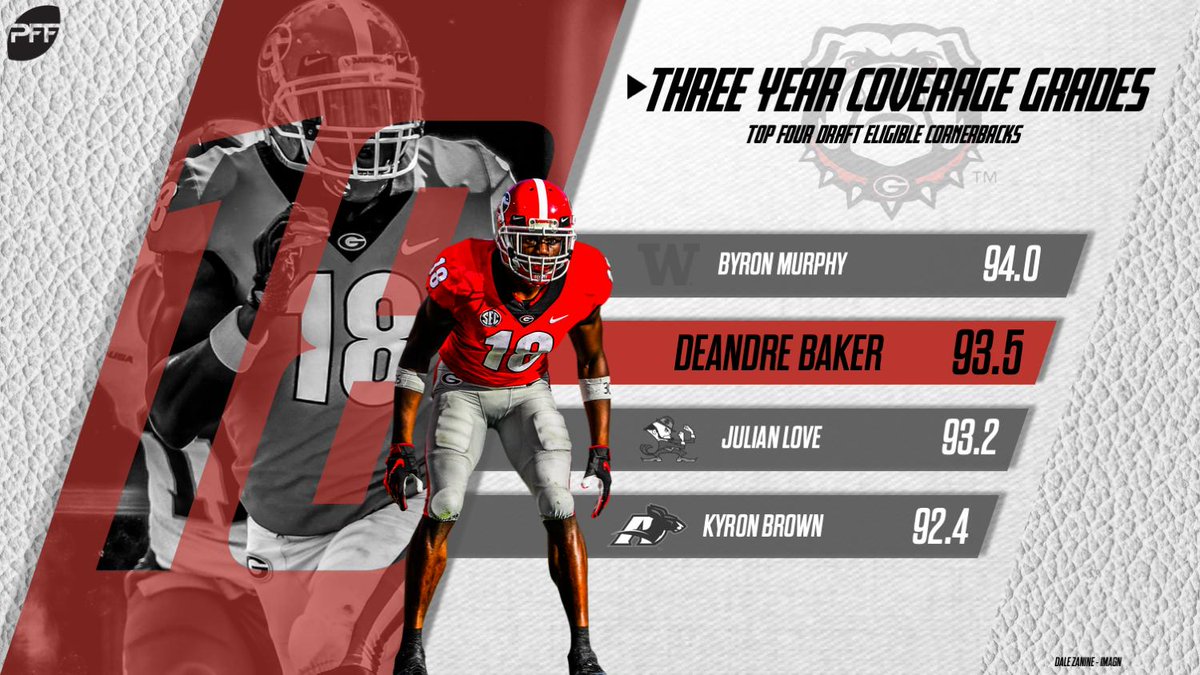

Competent offensive line play is difficult to find in the NFL, and no team has proved that more over recent seasons than the Houston Texans, who have now surrendered 200-plus quarterback pressures in three consecutive seasons. It may not have been as bad as last year (where they allowed 253 pressures), but they still allowed 31 sacks, 32 hits and 150 hurries from their 623 dropbacks in 2018. Whichever way you slice it, the one position the Texans should really focus on is offensive tackle; starters Martinas Rankin and Julie’n Davenport finished the 2018 season ranked 80th and 73rd among the 80 qualifying players at the position, respectively. The Texans really need to protect their young quarterback for sustained success.
Draft target: Dalton Risner, T, Kansas State
Risner would represent a significant upgrade for the Texans, and he could very well be there at Pick 23. Risner was a monster during all four years of his college career — his career-low grade was 87.9 overall, and he allowed only one sack in during his time at KSU.

The Indianapolis Colts had quite the bounce-back season in 2018 with new head coach Frank Reich orchestrating the offense and Andrew Luck back to full health, and they will look to strengthen the team further in the upcoming NFL draft. What Luck does lack in Indy, is a playmaker on the outside opposite T.Y. Hilton, and the addition of such a player could very well take the team back to AFC Championship glory.
Draft target: Hakeem Butler, WR, Iowa State
Butler had the best year of his college career this past season with Iowa State, finishing with a career-high overall offensive grade of 82.4. Butler’s size (6-foot-5, 227 pounds) might suggest a possession receiver, but he had more receptions of 20-plus yards downfield (19) than anyone in the draft class, and he would give the Colts an immediate and recognizable upgrade at the position.
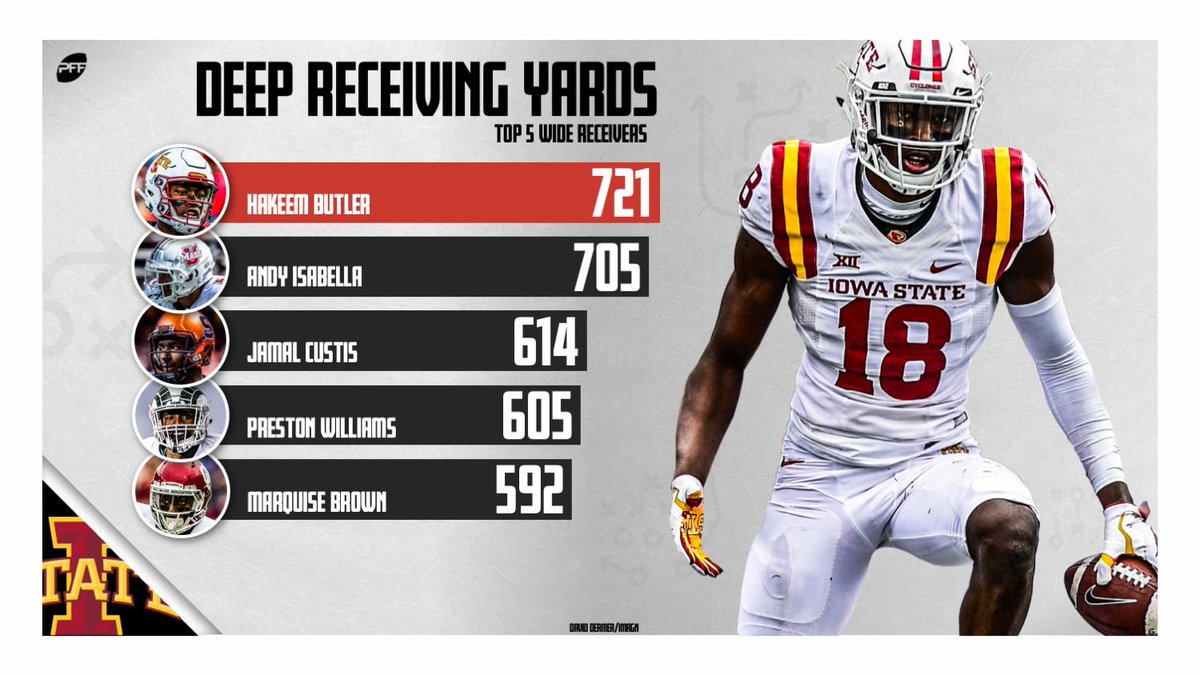

As a team, the Jacksonville Jaguars finished with the third-worst offensive grade in the entire NFL in 2018, and after they signed quarterback Nick Foles to a four-year deal, the team should focus on giving him more weapons to throw to and drafting talented players that will protect him. Last season, the Jaguars had the second-lowest receiving grade as well as the 26th-ranked pass-blocking grade, suggesting they'll likely go one of those two ways early in the draft.
Draft target: D.K Metcalf, WR, Ole Miss
Metcalf has almost everything that NFL teams want in a wide receiver prospect. He measures in at an imposing 6-foot-4 and is extremely explosive as he showed at the combine. He finished the season with a 72.8 receiving grade and a career-high in yards after contact and passer rating when targeted, despite only seeing 42 targets on the year. With all the physical tools at his disposal, Metcalf could find himself a home in Florida with Nick Foles at the helm.

Entering the draft, the Tennessee Titans need additional help along the defensive line, help along the interior of the offensive line and a reliable receiving threat to help out quarterback Marcus Mariota. The team ended the 2018 season ranked 22nd in pass-rushing grade last season, and the losses of Brian Orakpo and Derrick Morgan now open that pass-rushing hole even further. On the offensive side of the ball, Corey Davis had a good sophomore campaign, finishing with a 75.8 receiving grade, but no other receiver finished with more than 500 receiving yards on the year.
Draft target: Christian Wilkins, DI, Clemson
Christian Wilkins and Dexter Lawrence make up two of the best interior defenders in the country, and the Titans could look toward either of the Clemson game-wreckers in the upcoming draft, but the added boost the Wilkins gives from a pass-rushing perspective sees him get the nod here. Wilkins had the best year of his college career this past year, where he finished in the top three in both run-defense and pass-rushing grade among interior defensive linemen.
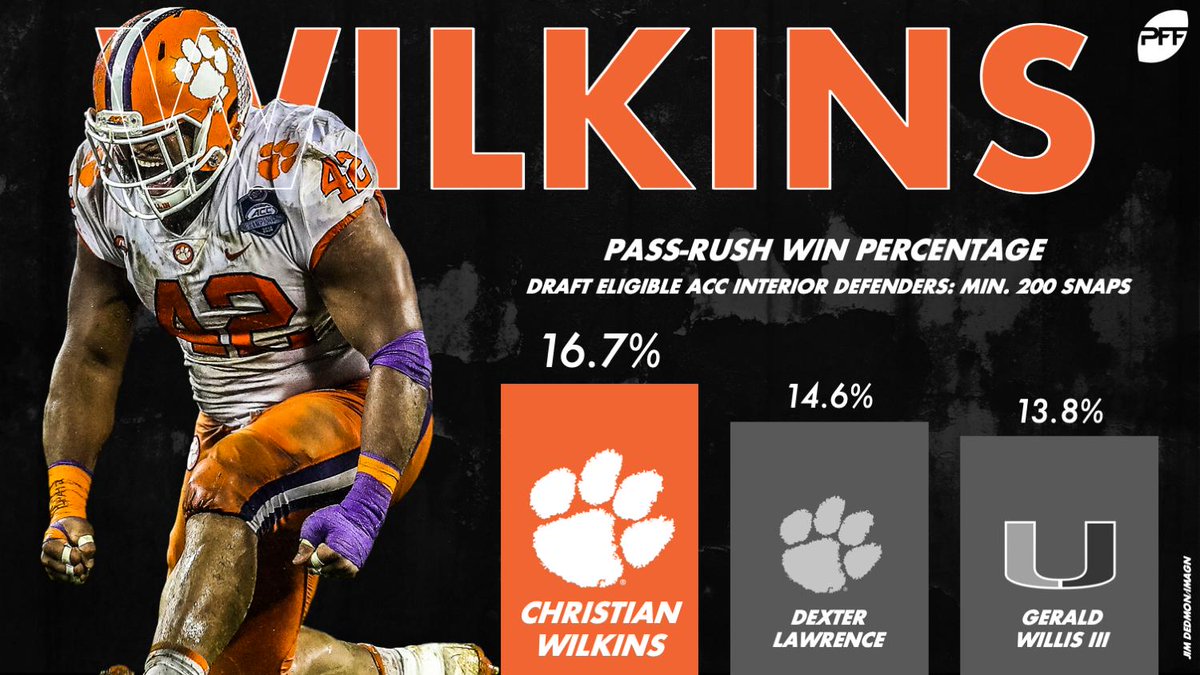

A young signal-caller is likely headed to Mile High to learn under the former Super Bowl MVP for at least a season, but the Broncos shouldn’t stop there at recreating their offense. Emmanuel Sanders isn’t getting any younger, and Courtland Sutton will likely need to do more to be considered a real outside threat in Year 2, as those two represent the top targets for Flacco at this time. On the defensive side of the ball, the Broncos brought in reinforcements for the secondary with the signings of Bryce Callahan and Kareem Jackson, but after losing long-time linebacker Brandon Marshall in free agency, the linebacker spot also figures to be a position of need.
Draft target: Devin White, LB, LSU
A top-15 player on our big board, no linebacker in college football had a higher grade in coverage than White’s 91.6 last season, and his freakish athleticism suggests it was no fluke. Vic Fangio’s defense stresses athletic linebackers and White fits that bill perfectly.

The Kansas City Chiefs had one of the most explosive and dynamic offenses in the entire NFL last season, and they earned the second-highest overall grade as well as the second-highest team passing grade. However, on the other side of the ball, the Chiefs just were not up to scratch, especially on the backend, which was a major reason why they ended the season with the league’s 26th-ranked coverage grade. Coverage is imperative for a defense to succeed in and if the Chiefs don’t do something to secure the services of top-notch coverage defenders at the position, you can expect that to draw the ire of Chiefs’ fans.
Draft target: Deandre Baker, CB, Georgia
Best cornerback available is likely the pick, and Baker is the least scheme dependent of the top group of corners. The Georgia product followed up a very good 2017 season with an excellent 2018 season, which he finished with an elite coverage grade of 90.0 — the second-highest coverage grade among corners in the SEC. This past year, he allowed all of 10 first downs all season, he allowed no touchdowns, and he allowed a passer rating of just 40.2 on throws into his coverage.

As things stand, the Chargers have one of the more well-rounded rosters in the NFL, which means that they should focus on a need that has been pressing for quite some time: offensive line. While they finished the season as the eighth-highest graded team overall in the regular season, they hobbled their way to the second-lowest team pass-blocking grade. Russell Okung was the one decent bright side for the Chargers in 2018, as he finished with a pass-blocking grade of 77.8, but everybody else did not fare so well. Michael Schofield and Mike Pouncey finished with pass-blocking grades of 70.7 and 67.4, respectively, while right Tackle Sam Tevi and left guard Dan Feeney earned pass-blocking grades of 40.1 and 38.1, respectively.
Draft target: Max Scharping, T, Northern Illinois
Scharping performed well over the course of his college career and earned pass-blocking grades above 87.0 every season. During his entire career with the Huskies, he only allowed five sacks, and four of those sacks came in his freshman year. With players like Cody Ford and Andre Dillard likely getting taken ahead of Pick 28, the Chargers could get a good consolation in Scharping.
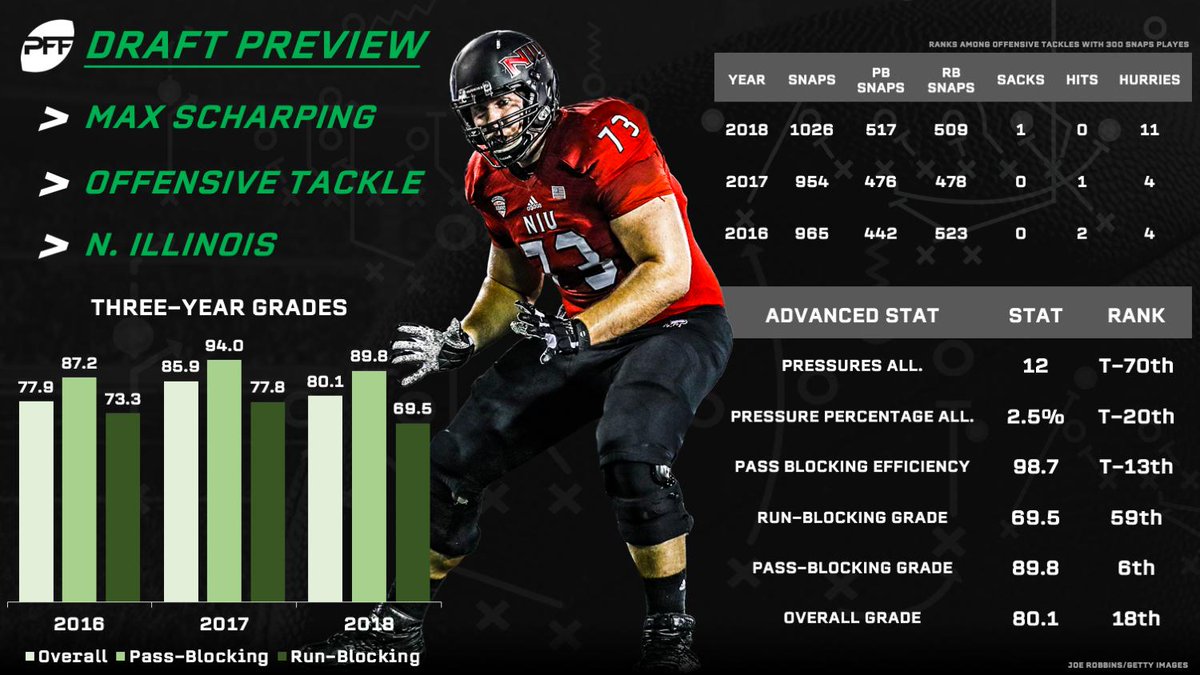

The Oakland Raiders have had a bumpy start to the second edition of the Jon Gruden era, to say the least. The one positive (if there can be such a thing) from the Amari Cooper & Khalil Mack trades is that the Raiders have three first-round picks to work with this year. The first point of order should be the pass-rush. The Raiders were the league’s lowest-graded unit in terms of pass-rush grade a season ago and stopping at nothing short of a dominant edge rusher in the first round would certainly be seen as a loss.
Draft target: Josh Allen, Edge, Kentucky
Allen put up the highest pass-rush grade in the nation last year at 94.3, and he led the SEC in total quarterback pressures a season ago, with 57. With Allen still likely available at Pick 4, the Raiders will likely have the chance to select the best player available at the position they simply need to fill.

Dallas was a middle-of-the-pack team last year in terms of receiving grade, but the midseason acquisition of Amari Cooper strongly buoys that figure. Prior to the Cooper trade, Dallas ranked 26th in team receiving grade (Weeks 1-8) before ranking 10th in team receiving grade from Weeks 9-17. Dallas should be in the market for pass-catching positions early, and perhaps even often, as passing is by far the most important aspect of football, but they could also look to further build on a defense that has been on the rise over recent seasons.
Draft target: Darnell Savage, S, Maryland
Savage has back-to-back seasons with grades over 86.0 overall. He’s a missile around the line of scrimmage, laying some impressive hits in the flat. He's one of our favorite free safeties in the class, and he can arguably cover more ground in the middle of the field than any safety on the Cowboys roster. He would pair exceptionally well with their athletic linebackers, and he would make an already strong defense stronger.

Despite the glaring need to create a plan to replace Eli Manning, Saquon Barkley was selected second overall last draft, and despite having a great season by all standards, his value at the top of the 2018 NFL Draft is still questionable as the Giants won just five games with Manning at the helm. It’s highly likely that New York will go quarterback with the sixth pick, and they still have other holes to fix throughout the draft as they were the 27th-ranked coverage unit in football in 2018. Their highest-graded cornerback played just 429 snaps, and Janoris Jenkins allowed seven touchdowns in his coverage a season ago. Still, quarterback is the biggest position of need in the Big Apple.
Draft target: Dwayne Haskins, QB, Ohio State
The Giants will likely need to trade up to get Haskins, but if he should fall to them, they should be happy to add him as their next signal-caller to build around. He logged the nation's third-best passer rating from a clean pocket (135.4), while his 4.9% big-time throw rate was good for fourth.
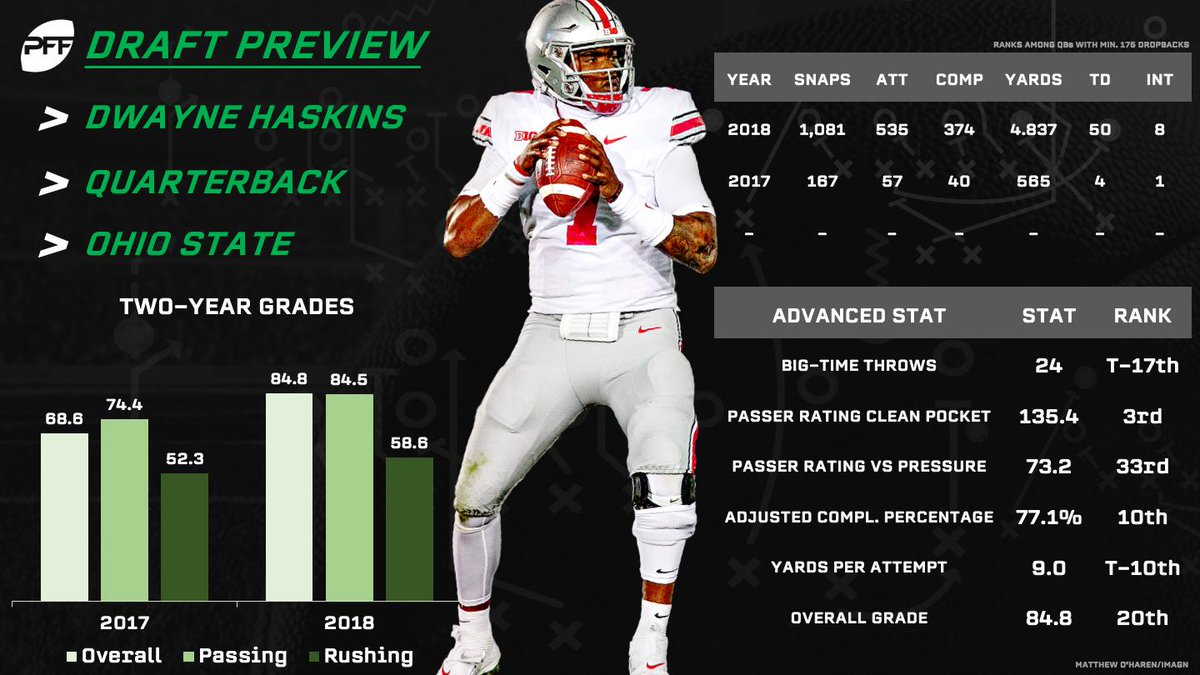

The Eagles’ defensive line is arguably one of the league’s best with Fletcher Cox and Brandon Graham manning the ship, but behind them, question marks pop up all over. The loss of Jordan Hicks hurts their linebacking corps, as he was well above average in coverage and after Hicks, Nigel Bradham was the team’s highest-graded linebacker at 67.5. Even with the return of Bradham and Ronald Darby at cornerback, every Philadelphia fan saw what happened a season ago when injuries depleted an already-thin unit at cornerback. Coverage is the most essential facet in the NFL for a defense and getting players who can contribute in key passing downs at both linebacker and cornerback should be priority No. 1 for the Eagles.
Draft target: Devin Bush, LB, Michigan
Bush can be a weapon as a blitzer in the right scheme. He had top-five pass-rushing grades among off-ball linebackers each of the past two seasons and has racked up 47 pressures, including 13 sacks, over that span. Bush’s 4.43 speed shows up on the field, and he'd make an impact in coverage for a team that badly needs it.

Case Keenum isn’t likely the answer for the long term in our nation’s capital, and it’s unclear whether or not Alex Smith will ever play again after his injury and subsequent troubles following surgery. The Redskins may not have their choice of a top signal-caller with the 15th pick, but in a draft class that lacks a true No. 1 quarterback after Kyler Murray, the middle of the first round may be the spot where you can risk a selection on a potential boom-or-bust quarterback of the future. Still, a quarterback needs targets, and reliable ones at that, which is another position the Redskins must address in April. No receiver finished with a grade above 65.0, and that was last year’s $40-million signing Paul Richardson, who ranked 71st among all receivers in overall grade. Jamison Crowder‘s exit presents a much-needed slot (pun intended) to fill as Crowder saw 306 targets come his way in his four seasons with the team.
Draft target: J.J Arcega Whiteside, WR, Stanford
Arcega-Whiteside’s ability to go up and high point the football while keeping opposing defenders at bay with his big 6-foot-2, 225-pound frame makes him almost uncoverable in jump-ball situations. He had 19 contested catches, which led the draft class, on only 32 contested targets last season. He could be the perfect complement to Keenum, who thrived with contested-catch weapons in Minnesota.
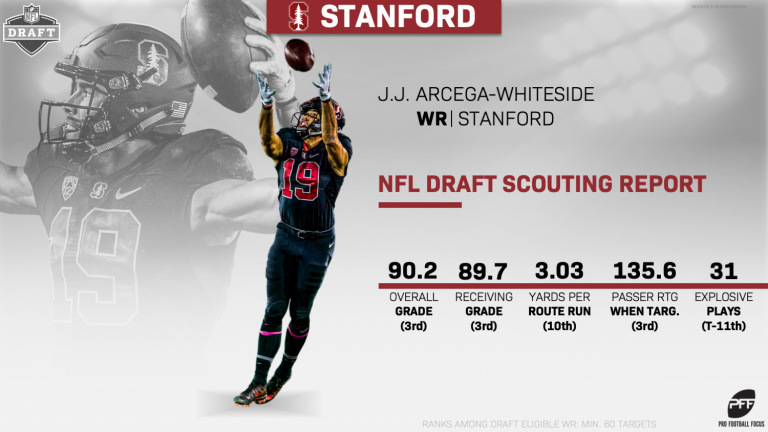

The Chicago Bears fielded an outstanding defense last season, with five of their starters grading north of 85.0. The trade for Khalil Mack paid off as he finished the season with the fifth-most pressures among edge defenders, and he helped push the Bears’ unit to the seventh pass-rushing grade as a team. However, outside of Mack, Leonard Floyd was the only other edge defender to tally more than 20 QB pressures, and he reached just 36 on 443 pass-rushes. They’ll be in the market for a pass-rusher who can get home with pressure as well as a defensive back to fill the void left by Bryce Callahan and Adrian Amos.
Draft target: David Long, CB, Michigan
The team may have signed Buster Skrine, but that shouldn't stop them from adding to the position. With few other needs on the roster, Long would add press-man skills and the potential to develop into the long-term solution across from Kyle Fuller. Long allowed all of 18 catches on 595 coverage snaps in his entire college career at Michigan.

Adding Damon Harrison via midseason trade and Trey Flowers via free agency, the Lions defensive line is a force to be reckoned with. However, the addition of one more top-tier edge rusher opposite Flowers would likely take the line from very good to great. Elsewhere, it was a bleak state of affairs for the Lions in coverage last season, especially at the cornerback position where former second-round pick Teez Tabor gave up a perfect passer rating on targets thrown his direction. Tabor gave up 22 receptions on 27 targets for 371 yards (16.9 yards per catch) and four touchdowns without making a play on the ball before being benched. Still, their pass-rushing unit a season ago finished with the 30th-ranked pass-rushing grade as a unit and a viable option opposite Flowers as currently only Romeo Okwara is penciled in as the team's other starting edge defender.
Draft target: Brian Burns, Edge, Florida State
Burns adds a different dynamic off the edge with his burst as a pass-rusher. He finished with an excellent 90.5 pass-rush grade last season to go with 66 total pressures, good for No. 2 in the nation during the regular season.

Ha Ha Clinton-Dix is out, and Adrian Amos is in as one of our favorite deals of free agency. However, opposite Amos will likely be Josh Jones if they weren’t to address the position further in the draft. A year removed from selecting two cornerbacks with their first two picks, the Packers seemingly know the importance of coverage on the backend, but they should also be wary of the fact that they lack in the game’s second-most valuable facet: receiving. Randall Cobb is a Dallas Cowboy, and Davante Adams is as good as they come, but he can’t do it all by himself. A trio of second-year players will likely see extended time as Equanimeous St. Brown, Marquez Valdes-Scantling and J’Mon Moore each impressed at times a season (albeit some in preseason), but another viable target for Aaron Rodgers seems vital.
Draft target: Andy Isabella, WR, UMass
Isabella was the highest-graded wide receiver in the country a season ago, racking up 1,696 yards, including 219 against FBS opponent Georgia. A speedy deep threat on the outside, Isabella would add a vertical weapon to the Green Bay offense and would be a steal should he fall to them in the draft.

Kirk Cousins put up a good but not great first season with Minnesota, in which he tied his career-high in touchdowns and finished with an overall offensive grade of 79.3 — the second-best grade of his career. The Vikings have the requisite receiving weapons in Stefon Diggs and Adam Thielen, but the one thing they don't have to help him out is a solid offensive line. A season ago, the Vikings did not have a single offensive lineman who graded above a 75.0 in either run blocking or pass-blocking.
Draft target: Cody Ford, T, Oklahoma
With Jonah Williams likely taken somewhere above them, getting Ford wouldn't be a bad pick up by any means. This past season at Oklahoma was Ford's first full-time season with the Sooners and he finished with a pass blocking grade of 85.2, which ranked third in the Big 12 among tackles.
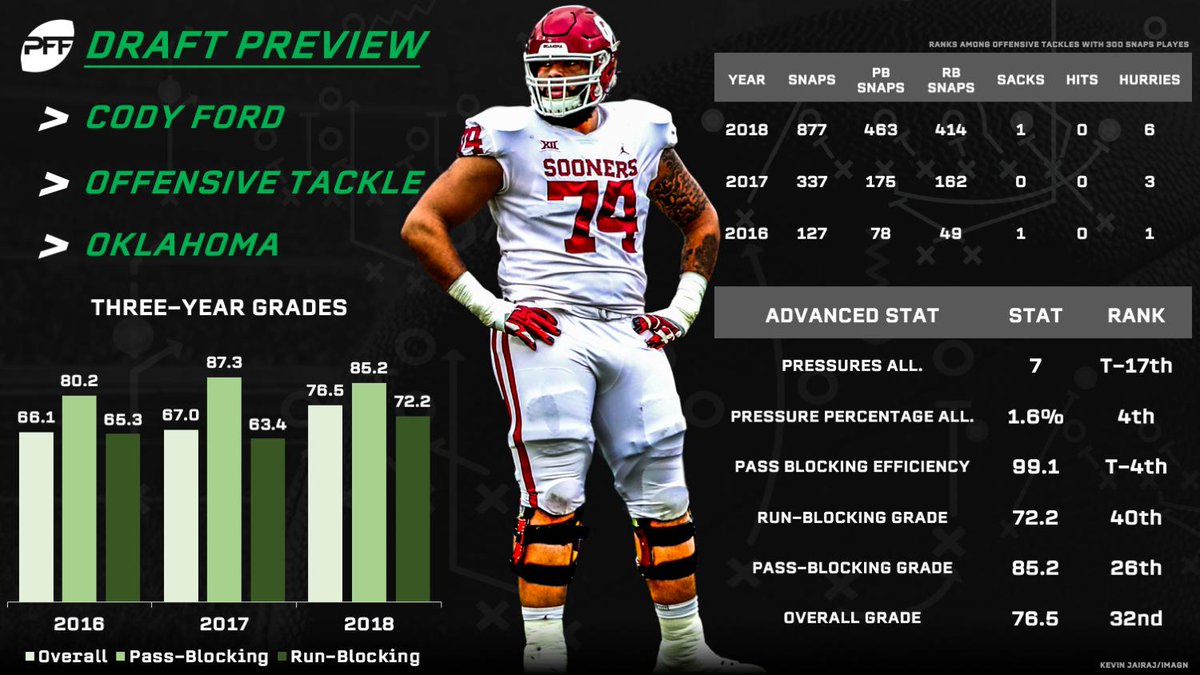

Atlanta drafted Isaiah Oliver a season ago, and while he impressed in Year 1, there is very little depth behind him and Desmond Trufant, who certainly isn’t getting any younger. Blidi Wreh-Wilson represents the team’s current third cornerback, but he’s coming off a season in which he played just 30 total snaps. Injuries decimated the Falcons as a whole on defense, so valuable additions along the depth chart at both cornerback and along the edge should be top priorities.
Draft target: Rashan Gary, Edge, Michigan
The former five-star recruit has incredible size and athleticism, dripping with “potential” and “upside,” though the on-field results have been good, not great by PFF standards, which could make him quite the pickup for the Falcons down the draft. He earned a 68.3 pass-rushing grade this past season but has all the tools necessary to develop into a productive edge rusher.

Julius Peppers should next be seen in Canton in five years, as he officially retired from the game after years of pressuring NFC South and NFC North quarterbacks. Peppers’ void leaves just Mario Addison as the only edge player who recorded more than 25 pressures in 2018. Bruce Irvin was signed, but he managed just those 25 QB pressures a season ago, the lowest of his career since 2013. The need at cornerback is there just as the need to add a pass-rushing force off the edge, and in a talented group of edge defenders, there is likely to be someone high on their draft board with the second-round pick on Friday.
Draft target: Jachai Polite, Edge, Florida
Polite is another outstanding pass-rusher in a deep defensive line class, and he could present tremendous value for the Panthers later on in the draft after he struggled at the combine and his pro day at Florida. Polite had his best pass-rushing season by far this past season, finishing with 41 total pressures and a 91.0 pass-rushing grade which was good for third among of all defensive linemen in the SEC but has certainly seen his draft stock fall after poor testing measurables, meaning he could slide well into the second round.
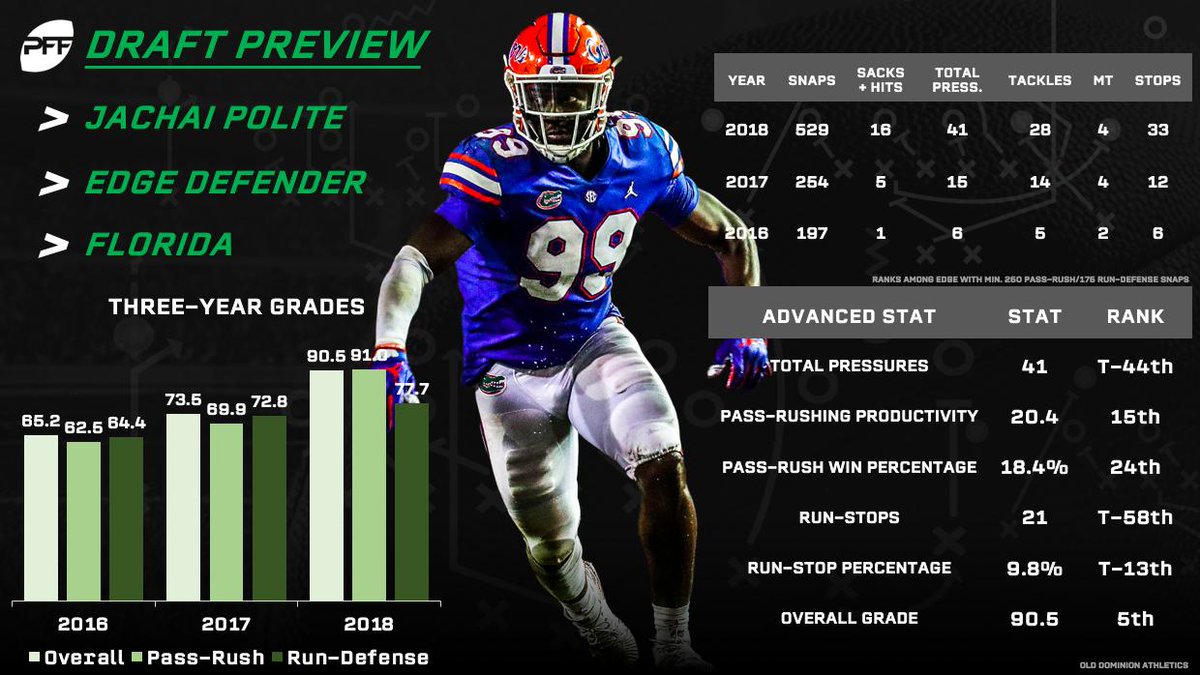

The Saints had another outstanding year offensively but on the other side of the ball, the cornerback play outside of Marshon Lattimore has been suspect. While the addition of Eli Apple improved things (albeit marginally) down the stretch, the team would certainly benefit from adding another talented cornerback into the mix.
Draft target: Julian Love, CB, Notre Dame
Last year's trade up for Marcus Davenport relieved the Saints of their first-round pick this year, but there's still plenty of talent to be had on Day 2 and beyond. Any sort of talent influx into the Saints secondary would be a welcome addition, and Love is a physical presence who could fill the slot from day one. His 21 forced incompletions were the sixth-most in college football last season, and his 14 coverage stops ranked 10th.

At their peak, the Buccaneers fielded one of the league's most explosive offenses last year. With players like O.J. Howard, Mike Evans and Chris Godwin (all of whom graded above a 75.0 last year) at his disposal, head coach Bruce Arians will look to keep it alive and kicking, but he could certainly use a few reinforcements on the interior of the offensive line. The team’s most pressing need, however, is cornerback after they finished with the 28th-ranked coverage unit last year. The long term plans at cornerback between Carlton Davis and M.J. Stewart were shaky in their first year with the team while Javien Elliott, the team’s highest-graded full-time player at the position is still a free agent. The loss of Kwon Alexander in the middle of the defense also will go a long way even despite his missed-tackle woes. The acquisition of Shaquil Barrett and Deone Bucannon on one-year deals aren’t the solutions for the future more than they are a band-aid to fix massive gaps on the team currently and defense first in the 2019 draft should be their top priority.
Draft target: Greedy Williams, CB, LSU
Williams is the best man coverage cornerback in the draft, and the new defensive scheme in Tampa Bay fits his skillset after he allowed a passer rating of only 42.5 during his career at LSU.

The weak link along the Rams’ offensive line last season was at center as John Sullivan limped to a 51.7 overall grade, which was the 34th-ranked grade at the position. With Rodger Saffold‘s departure from the guard spot, the interior offensive line is a key area for the defending NFC Champs to attack in the class and with Brian Allen the only center on the roster right now; it makes the most sense to start there. Adding a valued pass-rusher outside of the league’s best defensive player in Aaron Donald should only free up more one-on-one situations for the All-Pro in the interior.
Draft target: Garrett Bradbury, C, NC State
Bradbury was a top-five graded center each of the past two seasons and the highest-graded Power-5 center in this draft. He’s an ideal fit for the Rams and their outside zone scheme and he is extremely quick off the ball in the run game, while he's capable of making the highlight-reel reach blocks necessary for a zone-blocking center.
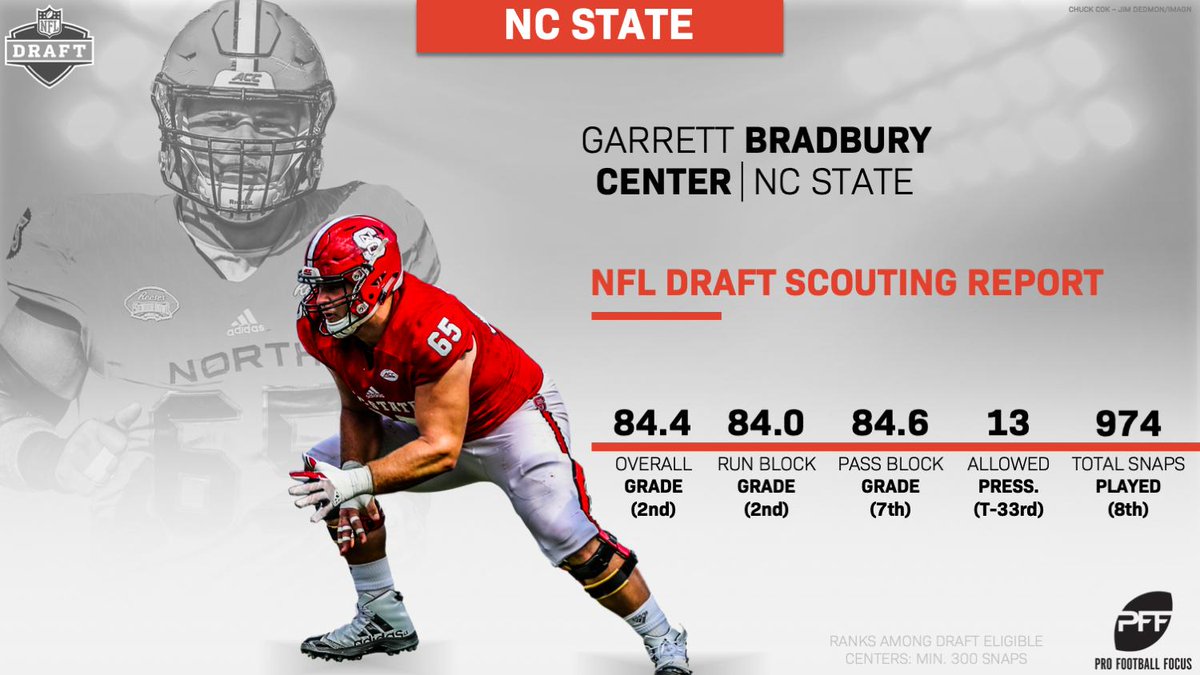

The Cardinals are rumored to Kyler Murray in more ways than one at the top of the 2019 NFL Draft, and while the discussion is whether to trade former first-round pick Josh Rosen or not, there is no reason why the team couldn’t keep both signal-callers and go with the winner from camp. The idea of being married to a first-round pick as a starter right away doesn’t have to take effect next season, and the duo battling it out to be the best could be the ideal situation in the desert. Still, the Cardinals have needs elsewhere, and that mainly is true of their offensive line which has struggled for years now. They were the league’s lowest-graded pass-blocking unit while possessing the NFL’s 22nd-lowest run-blocking group. Any acquisition in the early stages of the draft will almost certainly be an upgrade over a unit that allowed 218 total pressures a season ago.
Draft target: Tytus Howard, T, Alabama State
The Cards have had months to decide who to take with the first overall pick of the 2019 NFL Draft, and as of now, it's looking likely that Oklahoma signal caller Kyler Murray will be the guy. The first order of business should be to surround him with talent that can help him succeed. The top of the second round seems like the perfect place to take a skill position like wide receiver, where someone like Andy Isabella or Diontae Johnson could still be available, which leaves the third round and later to address the offensive line. Howard, who would likely still be available here, held up very well in his time against FBS competition, pitching a shutout on 38 pass-blocking snaps against Auburn this past season. He also had the highest win rate of any tackle in the 1-on-1s at the Senior Bowl and his overall grade when lined up at right tackle is the second-highest grade in the class.
 Last year, the Seahawks graded in the bottom half of the NFL in both pass blocking and run blocking, with the worst performers coming from the interior. No interior offensive linemen graded above 60.0 in the running game a season ago, and only one player graded above 60.0 as a pass blocker, that player being D.J. Fluker, who graded out at 75.1. Another weakness the Seahawks could address this upcoming offseason is their lack of pass-rush, primarily from the interior. The team came out on top after the trade of Frank Clark, giving them an additional first- and second-rounder to work with and they can easily stand to use that ammunition to select a player that can fill his shoes at a fraction of the cost.
Last year, the Seahawks graded in the bottom half of the NFL in both pass blocking and run blocking, with the worst performers coming from the interior. No interior offensive linemen graded above 60.0 in the running game a season ago, and only one player graded above 60.0 as a pass blocker, that player being D.J. Fluker, who graded out at 75.1. Another weakness the Seahawks could address this upcoming offseason is their lack of pass-rush, primarily from the interior. The team came out on top after the trade of Frank Clark, giving them an additional first- and second-rounder to work with and they can easily stand to use that ammunition to select a player that can fill his shoes at a fraction of the cost.
Draft target: Jerry Tillery, DI, Notre Dame
Tillery tied Quinnen Williams for the highest pass-rushing grade among interior defenders in college football last year. His sack totals don’t tell the whole story as he was a dominant week in and week out, and he would provide a formidable presence along Seattle's defensive line. We like him much more than other outlets and believe he's a top-10 talent, so if he's there at Pick 21, Seattle should jump for joy.

Jimmy Garoppolo returns to man a 49ers offense void of playmakers on the outside. George Kittle is a bona fide star at tight end, but after him, the team’s highest receiving grades belong to Matt Breida and Kyle Juszczyk. San Francisco could use another receiver opposite Dante Pettis and even after the acquisition of Jordan Matthews, the team is locked into the 2019 season with a career-high receiving grade of 77.0, a figure that Marquise Goodwin put up in 2017. Mike Person and Laken Tomlinson struggled to move people for the run game while they each allowed at least 30 pressures a year ago and Person, the higher-graded of the duo, will be 31 when the season begins. But the most pressing need for the 49ers is certainly on the back end in coverage where the aging Richard Sherman and K’Waun Williams were the only two players to put up plus-grades on a unit that finished with the league’s lowest coverage grade last season. Bolstering the league’s worst coverage unit from 2018 certainly is a good idea.
Draft target: Taylor Rapp, S, Washington
Taylor Rapp and Byron Murphy made up two of the best secondary players in the entire Pac-12 a season ago. Since 2016, Rapp has increased his coverage grade every year, and he finished with an 89.8 coverage grade in 2018. Adding on to his coverage grade, Rapp allowed only a 12.0 passer rating in coverage — good for the second in his conference.
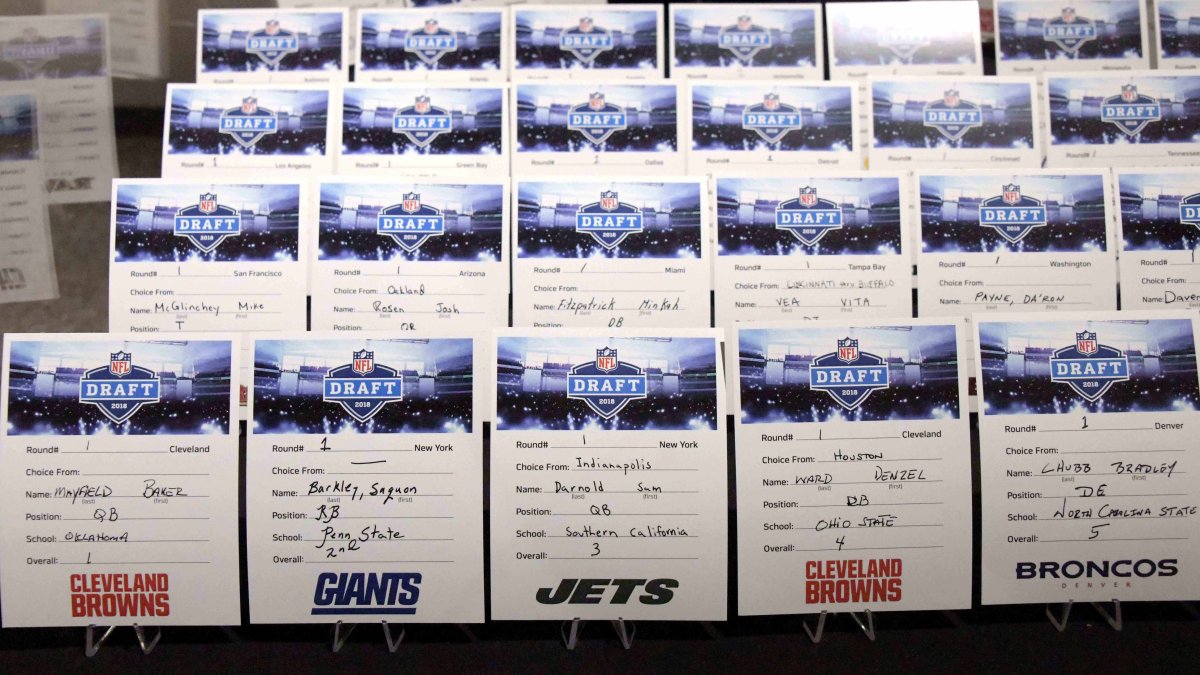







 © 2024 PFF - all rights reserved.
© 2024 PFF - all rights reserved.